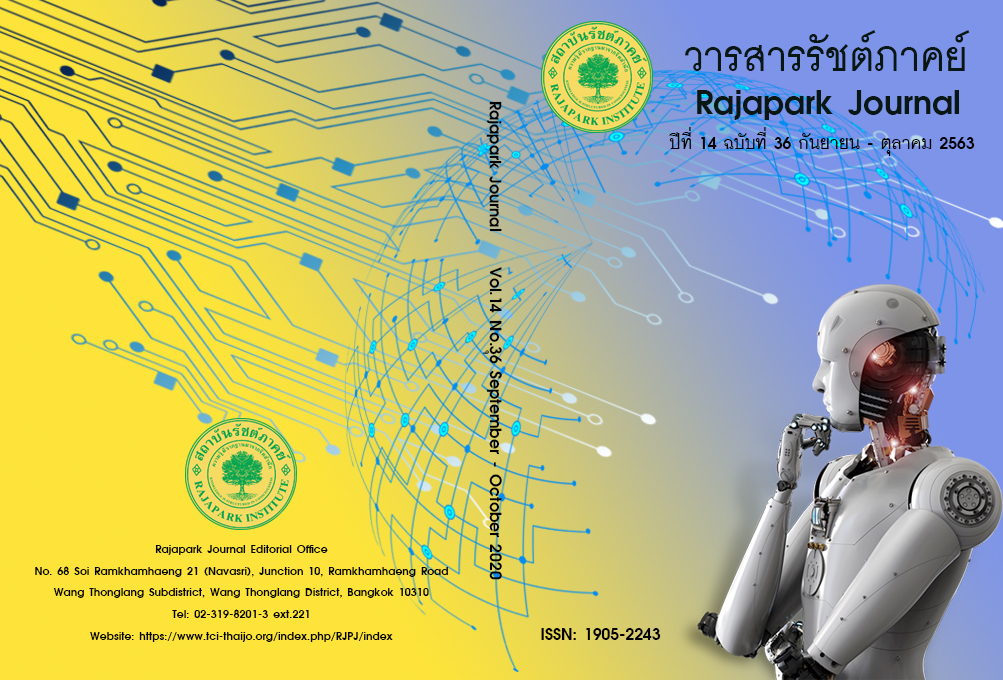Management of Flood Crisis in Thailand
Main Article Content
Abstract
The purpose of this research is (1) to study management methods for solving floods in crisis (2) to analyze factors affecting floods in crisis. It is a qualitative research by studying 4 areas, namely Pathum Thani Province 2011, Bangkok 2011, Surat Thani Province 2017, Nakhon Si Thammarat Province 2017, collecting data from 6 data group which are 1) Policy group management 2) Regional executive group 3) Local administrative group 4) Academic group 5) Flood-related worker group 6) People group of stakeholders through in-depth interviews and group conversation and with a triangular inspection. Research shows that flood management in a crisis must manage to solve the problem to a minimum with speed according to the area context at that time and according to the law does not affect the rights of citizens and operations of related departments and there should be an in-depth study of the implementation of the concept of the event command system as a guideline in operation. There should also be a comparative study of flood management in an international crisis, cooperation or integration of roles in Southeast Asia. To be able to use the information for flood management for more efficiency.
Article Details
Views and opinions appearing in the Journal it is the responsibility of the author of the article, and does not constitute the view and responsibility of the editorial team.
References
Aeksaengsee, K. (2015) The Crisis Management Leadership and Disaster Mitigation Water Management Strategy for the Modern Human Security: A Case Study of The Provinces in The Flood-Plane Areas of Central Thailand. Political Science Review Journal, Kasetsart University, 2(1), 97-110.
Agranoff, R., & McGuire, M. (2003). Collaborative public management: New strategies for local governments. Washington, DC: Georgetown University Press.
Coombs, W. T. (2007). Protecting Organization Reputations During a Crisis: The Development and Application of Situational Crisis Communication Theory. Corporate Reputation Review, 10(3), 163-176.
Coombs, W. T. (2012). Ongoing crisis communication: Planning, managing, and responding (3rd ed.). Thousand Oaks, California: Sage.
Covello, V. (1995). Risk Communication Paper. Opening the Black Box Risk Conference. Mcmaster University.
Department of Disaster Prevention and Mitigation. (2015). National Disaster Prevention and Mitigation Plan B.E. 2558 (2015). Bangkok: Department of Disaster Prevention and Mitigation, Ministry of Interior.
Deutsche, K. W. (1954). Political community at the international level problems of definition and measurement. New York: Doubleday.
Fearn-Banks, K. (2011). Crisis Communications: A casebook approach (4th ed). New York: Routledge.
Guilford, J. P. (1956). The structure of intellect. Psychological Bulletin, 53(4), 267–293. https://doi.org/10.1037/h0040755
Hill, M. J. (2005). The Public Policy Process. Pearson Longman.
Laohawichian, U., & Sangmahachai, S. (2017). Flood Prevention and Mitigation Management in Bangkok Metropolis. Kasem Bundit Journal, 18(2), 111-127.
NyBlom, S. E. (2003). Understanding crisis management: Risk assessment and planning are key to effective response. Professional Safety, 48(3), 18-25.
Office of the National Economic and Social Development Council. (2016). “Water and Plantation Management Plan”, Thai economy in the first quarter of 2016 and trends in 2016. Retrieved from https://www.nesdc.go.th/ewt_news.php?nid=5856&filename=index
Pearson, C. M., & Clair, J. A. (1998). Reframing Crisis Management. The Academy of Management Review, 23(1), 59-76.
Phatinawin, L., & Chobkatanyoo, A. (2011). Contagious Diseases and Floods: Situation and Surveillance. Bangkok: Samcharoen Panich.
Roseman, J. N. (1969). International Crisis as a Situational Variable: International Politics and Foreign Policy. New York: The free Press.
Shannon, C. E., & Weaver, W. (1949). The mathematical theory of communication. Urbana, Illinois: University of Illinois Press.
Slaiqeu, Karl A. (1984). Crisis Intervention. Massachusetts: Allyn and Bacon.
Stocker, K. P. (1997). A strategic approach to crisis management. In Clarke L. Caywood (Ed.), The handbook of strategic public relations & integrated communications. New York: McGrawHill.
Wankaew, S. et al. (2007). Tsunami Sociology: Disaster Response System. Bangkok: Social Research Institute, Chulalongkorn University.
White, G. F. (1945). Human Adjustments to Floods. University of Chicago. Department of Geography, Chicago, IL.


